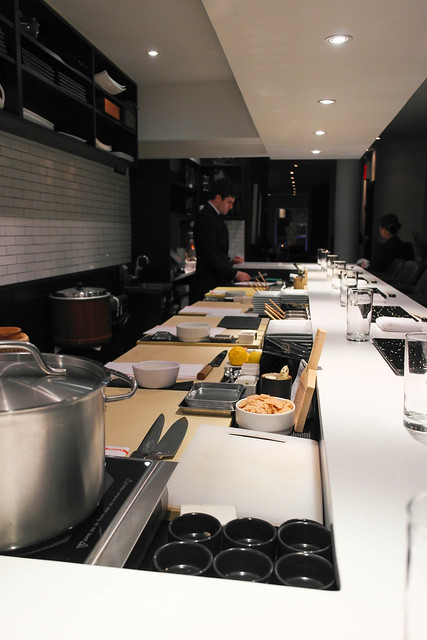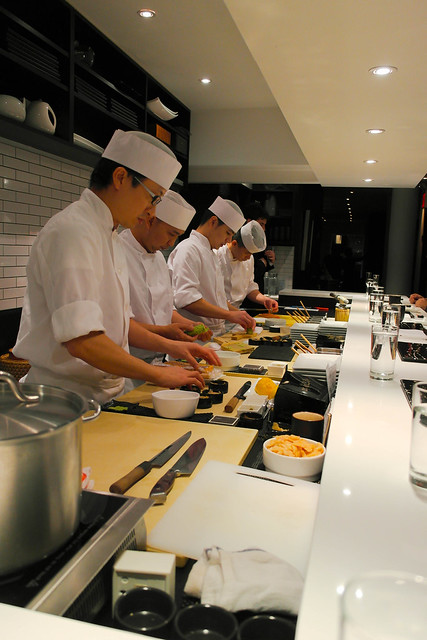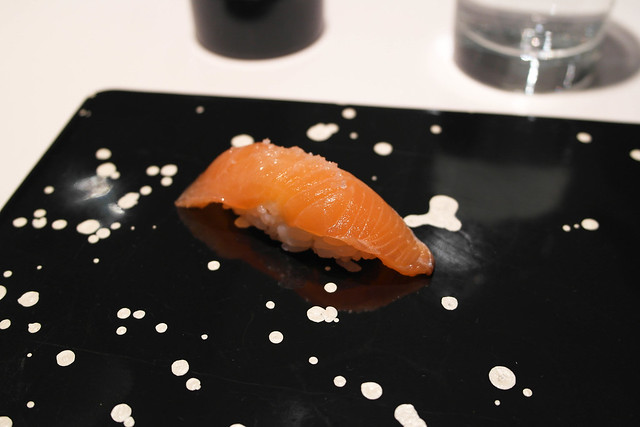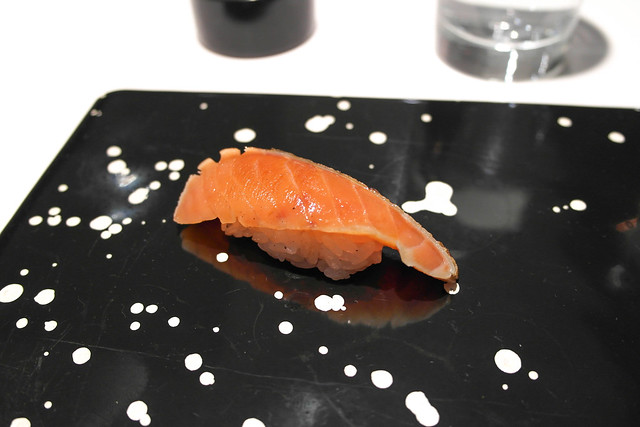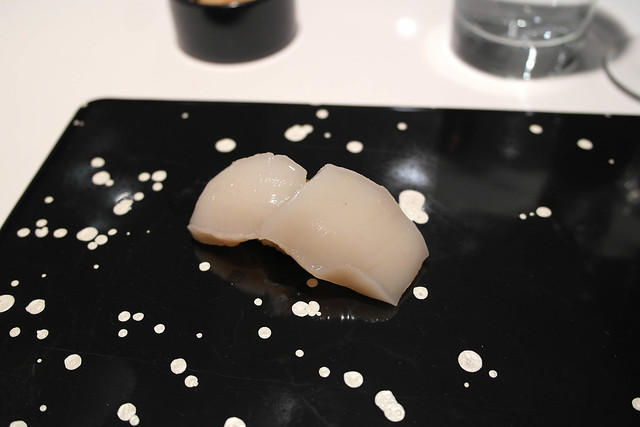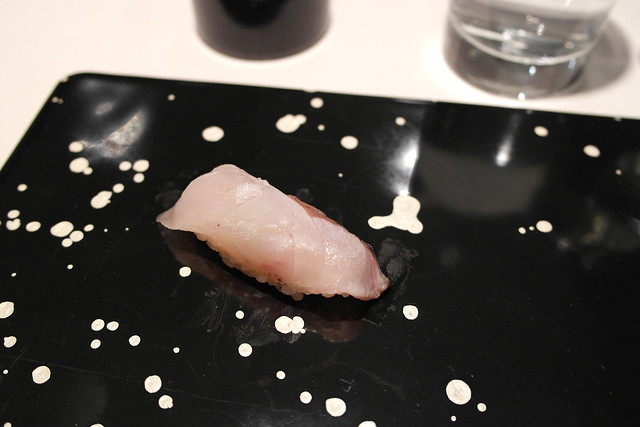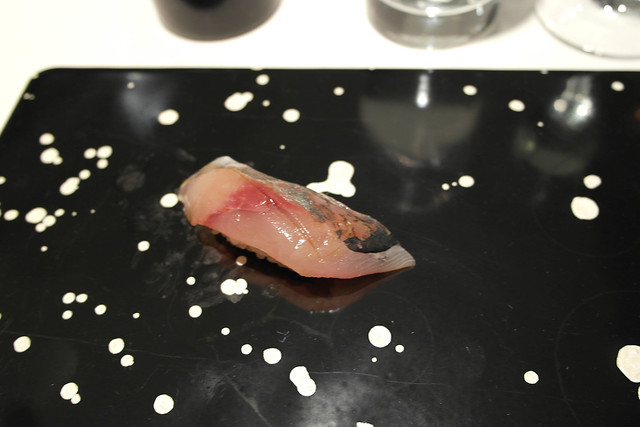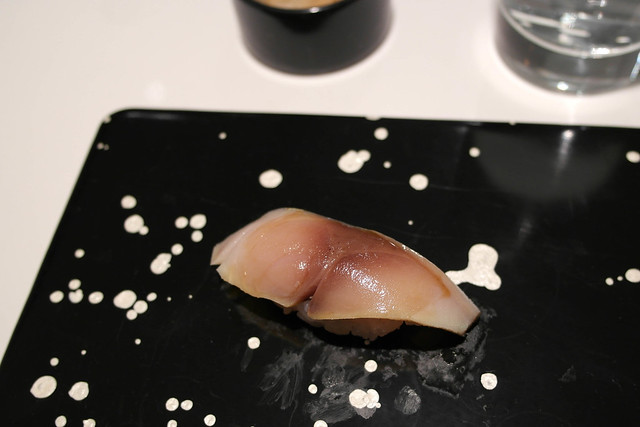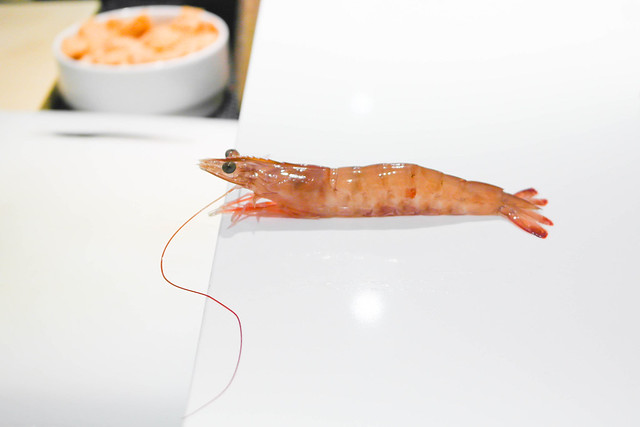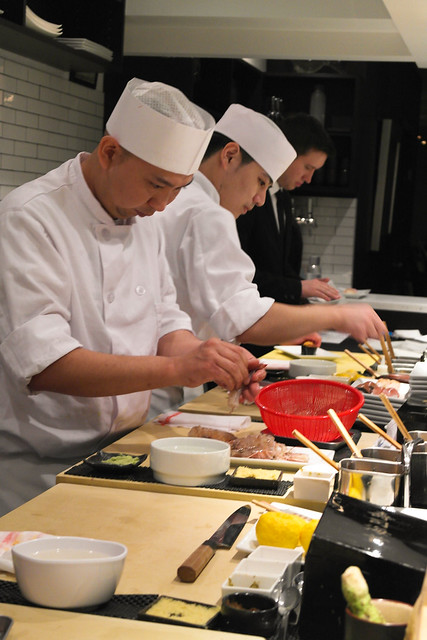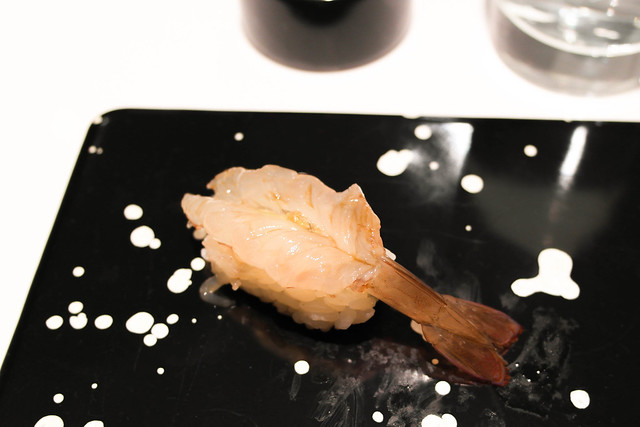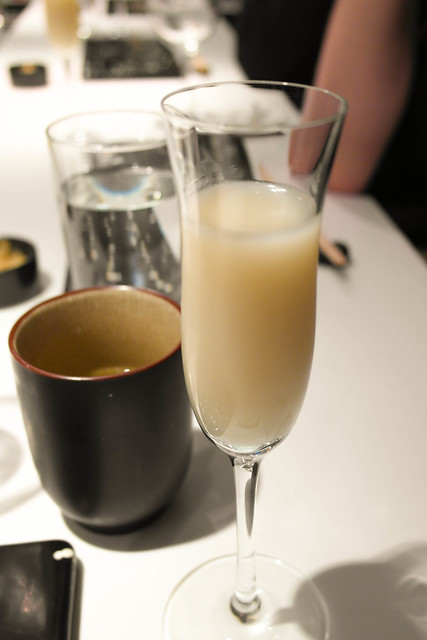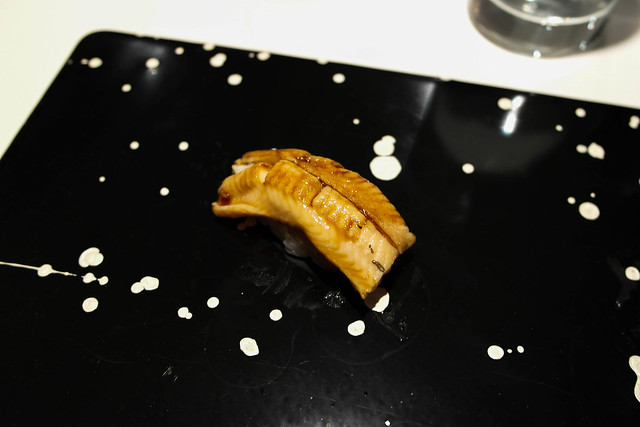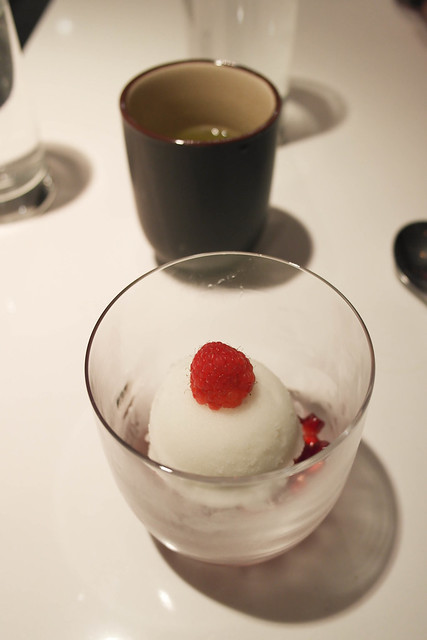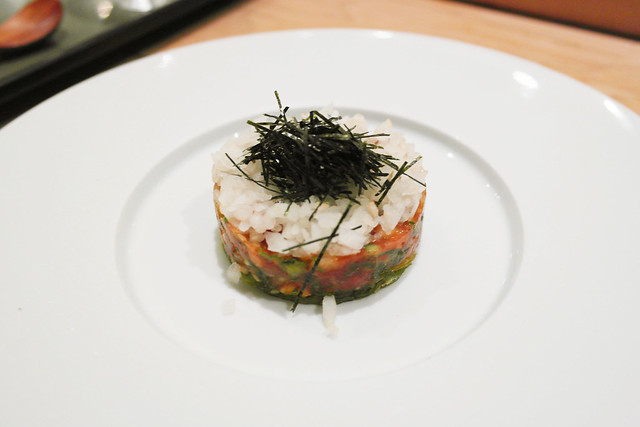
We found ourselves across the Hudson River three Fridays ago for a much needed date night at Thirty Acres. The restaurant had been sitting on my mind for quite some time (hat tip to Mr. Ryan Sutton during his tenure at Bloomberg), and we finally just decided to go for it. It was a super quick PATH ride to Grove Street in Jersey City (merely two stops from the Christopher Street station), so for the ambivalent New Yorker, no need to worry too much over logistics.

I quickly fell in love with the understated marriage of multicolored woods and industrial funk.

Chef Kevin and Alex Pemoulie, the husband-and-wife team behind this very Brooklynesque watering hole, actually began a Kickstarter campaign to open Thirty Acres back in December 2011. While the initial fundraising goal was $10,000, the campaign was met with such enthusiasm that thirty days later, it had raised a little over $18,000. With his experience as a chef at Momofuku Noodle Bar, Chef Pemoulie wanted to open Thirty Acres not only to "looking to showcase all that New Jersey has to offer" but to also continue developing Jersey City "by providing for our neighborhood locally grown and prepared products."

What I love about Thirty Acres is that it keeps the menu on its website as current as possible. Look at the flavor combinations that incorporate lovely seasonality with inspiring creativity!

As expected, the wines were categorized by color and arranged by increasing gradient (i.e., white to red). But what particularly intrigued Marcus about the wine list here was the unusual inclusion of orange as a category. While there was pink to indicate the restaurant's selection of rosés, we both had never heard of orange wine or any wines that were necessarily orange colored, so we weren't sure what that meant (Update: In the same fashion that red wine is fermented red grapes with skins, orange wine is the same, only with green grapes). There was only one way to find out, and that was how Marcus decided he would try the 2011 Bloomer Creek gewürztraminer from the Finger Lakes. I went with the other "non-traditional" shade and had the 2013 Channing Daughters refosco rosé from Bridgehampton, New York. Both were lovely and very fruit-forward (with the rosé a tad bit sweeter) -- perfect for the summer evening we were having.
We pretty much decided to share everything (with the exception of the second course dishes where we just stole a few bites from each other's plates), so here comes the rundown of what we ate.

First up with the chilled squid with chili shrimp vinaigrette, cilantro, and peanuts. Holy mackerel was this so incredibly good! I don't think I've ever had the pleasure of noshing on such tender pieces of chilled squid before. Not only was the texture and consistency done perfectly, the Asian-inspired flavors weren't any less punchy.

Here's a peek of what the dish looked like under the cilantro leaves. The flavors were bold with lots of heat from the vinaigrette and rounded out with the addition of peanuts. And man, the generous portion was shocking to say the least. I've been dining in New York City for way too long considering how spoiled I felt with each and every dish at Thirty Acres. Don't worry -- not one morsel of the squid was wasted.

Next we had the raw sea scallop with apricots, sugarplums, and tomatillos. Again, crazy me was expecting a crudo dish like this have the scallop diced into small cubes and plated in those Asian soup spoons (like a ceviche). I was pleasantly surprised to have my expectations thrown out the window to bear witness to such a colorfully playful dish. This is where you really see how Chef Pemoulie truly highlights the gorgeous produce of the summer season. I've never had a sugarplum before (could only guess what they might taste like from that number from The Nutcracker, haha), and it was ripened with a subtle sweetness to it. Pair it with the slightly denser apricots and the thin slices of tomatillos, and you have a striking combination with the scallops. While there seemed to be so much that could overwhelm the scallops, the overall dish remained very light, capturing the delicate essence of the scallop with these beautiful flavors.
The next dish that followed were shishito peppers with peaches, guanciale, and basil. I was interested to see how the flavor compilation would work here as it was something I had never really tasted before. Even Marcus teased me for really, really wanting to try them, but then again, would you trust someone who isn't very fond of peppers? I insisted that he just give them a try, only to get an answer, "Don't worry -- I'll just eat the bacon part." Well, not without a fight!, I thought. Instead, I just smirked to myself, knowing that he'd be proven wrong pretty soon.

The salty-savory crunch from the guanciale, sweet crisp from the slices of peach, and the juicy, mild heat from the shishitos made for a very satisfying combination. Marcus finally relented to my insisting on just trying a bite, pleasantly surprised at how spot-on of a dish it was. I have since been inspired to try to make these at home (just gotta figure out where to find those little shishitos...:P). Needless to say, we gobbled this up to the last morsel.
Our next wines consisted of a cabernet franc for me (2012 Aha Wines "Bebame" from El Dorado, California) and a riesling for Marcus (2011 Boundary Breaks "No. 198 Reserve" from Finger Lakes, New York). Both went really well with the following courses.

For the secound course, I opted for the spaghetti nero with cherry tomatoes, mussels, chili flakes, and oregano -- I mea, how could I have resisted another foray into the world of squid ink pasta? With the chili flakes really packing in a solid spicy punch to the course (so be prepared!), the pasta was a nice bitey al dente and the mussels a delicious tender bite. While it was a well-executed dish, I would have to say that it might be my least favorite (that is, if I had to pick one) of the evening just because it wasn't something that wowed me like the other dishes had.

Marcus went for the corn gnocchi with shrimp, basil, lime, and jalapeño. I had been under the impression that when you see gnocchi on a menu, it would almost always be the soft pillows of savory potato. So when the plate arrived to our table, I was quite taken aback by the appearance of said gnocchi. The exterior looked fried, boasting a crisp, golden brown shell -- pretty much resembling tater tots. After Marcus sampled a bite of each component, he motioned that I do the same. The inside of the gnocchi had a really sweet and savory fill of juicy white corn (which I assume comes straight from the Garden State) -- simply perfection with the generous pieces of shrimp and heat from the jalapeño. While we still remain a bit ambivalent about the frying technique used on the gnocchi here, the flavors layered here really captured the essence of summer very well.

For the main course, we shared the poussin (i.e., young chicken) with broccoli and spicy lobster broth. I've always been a fan of simple preparations (good ol' salt and pepper), and the poussin at Thirty Acres is no exception. It was simply roasted (at least from what I could see and taste), so the showstopping punch came from the spicy lobster broth. The broth was super concentrated, seeping the broccoli with the bold flavors from lobster shells and heat from chili flakes. Although I totally understand what this dish was trying to do, I felt that the broth was a tad over-salted and would've definitely been less intense if it was slightly diluted. However, since the flavors were spot-on, I still very much enjoyed all the elements together that dressed a perfectly cooked poussin.

For dessert, Marcus tried Kevin's Mom's lemon bar, and we came to the conclusion that this dessert is better to be shared than to be tackled on solo. It is a very tart lemon bar, making it a great dessert to be enjoyed after three bites. Any more might be a little too much.
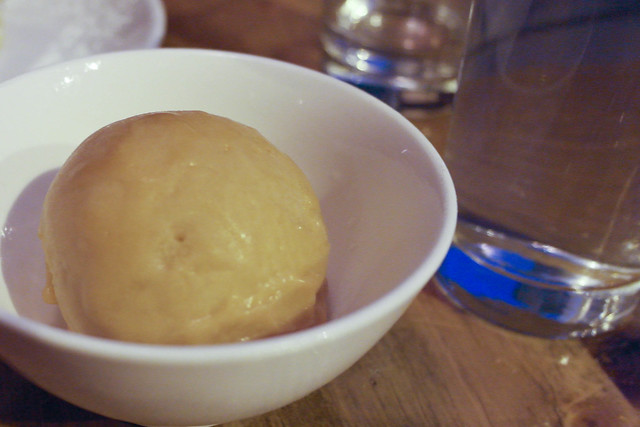
I had a single scoop of fresh peach sorbet, which tasted like the ripest summer peach, making for a lovely way to end a fantastic meal.
Findings: All in all, I was thoroughly impressed with the dishes we had at Thirty Acres -- to find cuisine of this caliber just a stone's throw away (okay well, across the Hudson) was both refreshing and hopeful. The seamless fusion of the Garden State's seasonal bounty with Chef Kevin Pemoulie's odd yet perfect flavor combinations weaves its way through the restaurant's fun menu, where you're bound to find something that'll wow and satisfy (ahem, the shishito peppers with guanciale and peaches come to mind). So don't be scared to venture from the Boroughvilles of NYC, or else you'll miss an awesome find like this one.
Price point: $11-14 for each first course; $16-17 for each second course; $28 for each main course; $5-6 for each dessert; $13-14 for each glass of wine.
--August 1, 2014
Thirty Acres
500 Jersey Avenue
Jersey City, NJ 07302
http://thirtyacres.tumblr.com


